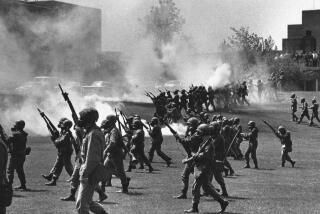Confusion, Not Coverup After Tillmanâs Death, Army Says
FT. BRAGG, N.C. â The Army general investigating the death of Pat Tillman acknowledged that the Army knew almost immediately that he had been killed by fellow soldiers rather than enemy fire, but blamed confusing regulations -- not a coverup -- for its failure to tell his family what really happened until after he was buried.
Brig. Gen. Gary M. Jones, speaking publicly on the matter for the first time, detailed the events surrounding the April 2004 death of the professional football player-turned-soldier in the mountains of Afghanistan.
Shortly after Tillmanâs death, the Army said he was killed while leading troops in battle, scaling a hill to ensure the safety of other U.S. soldiers following him. Days after his death, the Army awarded him the Silver Star, praising his gallantry under enemy fire. A few weeks later, the Army said he probably died as a result of so-called friendly fire.
In an interview, Jones expressed sympathy for the family of the 27-year-old onetime NFL star, who gave up a lucrative football contract in 2002 to join the Army. But Jones defended the Armyâs handling of the incident and said he had found no evidence of an attempt to hide the truth.
âThe evidence from my investigation tells me that no one attempted to cover up or conceal anything in the course of this investigation,â Jones said in the interview earlier this week at the Armyâs Special Operations Command. On Thursday, Army officials issued a statement saying they stood by those findings.
Jonesâ report represents the Armyâs latest effort at damage control for omitting from the first public accounts of Tillmanâs death what his fellow Army Rangers said they knew on the day of the shooting: that Tillmanâs comrades had accidentally killed him.
But the newest report stands little chance of calming criticism of the Pentagon for Tillmanâs death and how it was handled, especially from his relatives, who denounced the report Thursday.
Mary Tillman, the slain soldierâs mother, had been briefed by Army officials but said she did not accept the Armyâs latest account, which she said differed from some of the information in the six volumes of its written investigation.
âWhat the military says in the briefing and what is in the report are two different things, and weâre working on getting that document released under [the Freedom of Information Act] so the media can see it,â Tillman said Thursday in a telephone interview from her Bay Area office.
Jones said his heart went out to the Tillman family, which has reacted angrily at what they have described as apparent deception. âThey are in real pain,â Jones said.
But, he said, soldiers and commanders involved thought they were not supposed to talk about what happened until formal reviews had taken place.
âThere was a view at several levels of the command that it would be best to wait until the conclusion of the investigation before telling the family about any possible fratricide so that the family was not given what one commander characterized as a half-baked explanation of what happened,â Jones said.
In briefings given this spring to Tillmanâs mother, father and brother and to Sen. John McCain (R-Ariz.), Jones told them that information pointing to friendly fire initially had been withheld by lower-level commanders in a well-meaning attempt to spare the familyâs feelings before all the facts were known.
Withholding the information amounted to âan administrative error,â said Brig. Gen. Vincent Brooks, the head of Army public affairs.
Army Gen. John P. Abizaid, head of the U.S. Central Command, had been told it was a case of friendly fire at the time of the Silver Star award. The Tillman family was not told what had actually happened until a memorial service had been held. Jones recommended changes to Army rules, including a more explicit directive that troops not destroy evidence in the event of friendly-fire deaths. After Tillmanâs death, soldiers burned his uniform, saying it was a biohazard.
Also, Jones said, the commander on the ground should have clear discretion to tell soldiersâ families if they are believed to have died as a result of friendly fire, even if an investigation is still ongoing.
âIn my view, nothing has done more to create suspicion by the family as to the Armyâs intentions than failing to release that this was a potential fratricide as soon as that became known,â Jones said. âArmy regulations appear to be in conflict as to whether we should release that information or whether we must withhold it until the conclusion of the investigation.â
Unlike earlier accounts in which the Army said that Tillman probably died as a result of friendly fire, Jonesâ report concludes that the evidence leaves no doubt about the cause of his death. Among other things, U.S. ammunition was found embedded in Tillmanâs ballistic vest, the report said.
Jones upheld the awarding of the Silver Star to Tillman, even though he was killed before he could carry out his mission.
âThis plan was an audacious plan,â Jones said of Tillmanâs apparent intention to climb up a ridge with only two men and attack enemy gunmen. âBecause his untimely death prevented him from carrying it out, it does not in my view in any way detract from the valor he displayed and was about to display.â
Jones also defended the Armyâs decision to levy relatively light punishment to soldiers and officers in the unit. The most serious reprimand was for dereliction of duty. Four soldiers have been removed from the Rangers.
âThey thought this guy [Tillman] walked on water,â Jones said of the Rangers who fired on Tillman. âAnd they cared for him. And I know this hurt them deeply.â
The Silver Star citation, speedily crafted in time for his May 2004 memorial service, described how Tillman confronted âdevastating enemy fireâ with his âaudacious leadership.â
Local Afghans have said there were no enemy fighters in the area that night. However, Jonesâ report cited statements from Rangers who believed they were under fire. None of the military investigations disclosed the existence of any enemy dead at the scene in Paktia province or of any captured enemy weapons or spent shells.
A series of mishaps and possible mistakes preceded Tillmanâs death, according to Jonesâ investigation. First, Tillmanâs platoon split in two because of a disabled vehicle. As the first group -- which included Tillman -- moved ahead, it made a wrong turn, then heard explosions, which made soldiers believe the second group had come under attack.
Tillman, on foot, climbed a hill with another soldier and an Afghan militiaman, seeking to clear out enemy fighters. However, the arriving second group, seeing the Afghan militiaman and uncertain of who he was, began firing on Tillmanâs three-man squad. In one of the vehicles, a soldier stood, firing a .50-caliber machine gun at Tillmanâs squad. Tillman waved his arms, screamed his name and set off a smoke grenade to identify himself as a fellow Ranger, but the gunners continued their barrage.
A driver of one of vehicles recognized the group as fellow soldiers, grabbed the machine-gunnerâs leg and shouted, âCease fire! Friendlies on top.â However, Jones said, the machine-gunner thought the driver was yelling because he had been hit, and continued shooting at Tillmanâs group.
Afterward, Tillmanâs brother, Kevin, who was in the second group of vehicles, was ordered to guard the scene for 45 minutes before another Ranger told him his brother had been killed there.
Military officials, including the investigating general, insist that the Silver Star accounting of what happened was accurate, because Tillman believed he was under fire and intended to take dramatic action. Critics said the omission of key contextual information was misleading.
âIf the Army canât even be honest with the family of Pat Tillman, then how can the rest of America expect the Army to be honest with them?â asked Paul Rieckhoff, an Iraq war veteran and executive director of Operation Truth, a veterans group based in New York. âItâs clear that they tried to balloon this story and use it to their benefit at the expense of the family and the American people.â
Brooks of the Armyâs public affairs office called criticism of the Armyâs motives unfair. âTheyâre talking about intentions, and behaviors and deliberate malfeasance and coverups and that sort of thing,â he said. âAnd that is -- it is just not right.â
More to Read
Sign up for Essential California
The most important California stories and recommendations in your inbox every morning.
You may occasionally receive promotional content from the Los Angeles Times.









